A Fuzzy Energy Management Strategy for the Coordination of Electric Vehicle Charging in Low Voltage Distribution Grids
Abstract
1. Introduction
2. Grid Distribution System
2.1. System Topology
2.2. Technical Constraints for Grid Distribution System Operation
2.3. Electric Vehicle Agent
- The EV’s model, which defines the capacity of its battery and the energy consumption per km
- The EV’s index, which declares the location of its charging point to the grid
- The EV’s battery state-of-charge (SoC)
- The EV’s state, which defines if the vehicle takes a trip, is connected to grid and charging, or is parked
- The EV’s charging signal, which declares if the vehicle will charge at a given time interval and it is produced by the charging management algorithm
2.4. Fuzzy Logic Based Controllers
2.5. Modelling and Simulation Framework
3. Effects of EVs Penetration in Distribution Grids
3.1. Investigation of Maximum Chargeable EVs in the Case Study Grid
3.2. Investigation of Unctrolled Charging Effects on the Case Study Grid’s Buses and Lines
4. Fuzzy Charging Management System
4.1. Overview
| Algorithm 1 Selection of the Chargeable EVs | |
| 1: | for each time step do |
| 2: | Get the charging priorities of the EVs from the Fuzzy Logic Controller |
| 3: | Create a list for each phase that include the EVs to be charged and sorted in an ascending order of charging priority. |
| 4: | Perform grid’s power flow analysis |
| 5: | If voltage or ampacity violation occur in a phase then |
| 6: | Remove EV with the lowest priority from each corresponding list |
| 7: | Return to action 3 |
| 8: | else |
| 9: | Charge the selected EVs |
| 10: | end if |
| 11: | end for |
4.2. Proposed Fuzzy Interface System
4.3. Simulation Scenarios and Results
5. Conclusions
Author Contributions
Funding
Conflicts of Interest
Appendix A
| Scenario 1 | Scenario 2 | Scenario 3 | Scenario 4 | |||||||||
|---|---|---|---|---|---|---|---|---|---|---|---|---|
| EV Index | Tstand-by (min) | Tcharging (min) | Ttotal (min) | Tstand-by (min) | Tcharging (min) | Ttotal (min) | Tstand-by (min) | Tcharging (min) | Ttotal (min) | Tstand-by (min) | Tcharging (min) | Ttotal (min) |
| 1 | 3 | 50 | 53 | 0 | 59 | 59 | 0 | 60 | 60 | 0 | 141 | 141 |
| 2 | 5 | 43 | 48 | 0 | 46 | 46 | 1 | 44 | 45 | 1 | 118 | 119 |
| 3 | 5 | 51 | 56 | 0 | 43 | 43 | 0 | 53 | 53 | 0 | 134 | 134 |
| 4 | 41 | 123 | 164 | 14 | 119 | 133 | 2 | 135 | 137 | 6 | 233 | 239 |
| 5 | 35 | 57 | 92 | 26 | 48 | 74 | 3 | 56 | 59 | 0 | 126 | 126 |
| 6 | 4 | 50 | 54 | 0 | 42 | 42 | 0 | 59 | 59 | 0 | 134 | 134 |
| 7 | 55 | 49 | 104 | 20 | 54 | 74 | 5 | 47 | 52 | 0 | 206 | 206 |
| 8 | 9 | 59 | 68 | 0 | 60 | 60 | 0 | 48 | 48 | 0 | 222 | 222 |
| 9 | 60 | 38 | 98 | 22 | 46 | 68 | 0 | 39 | 39 | 20 | 172 | 192 |
| 10 | 33 | 125 | 158 | 36 | 130 | 166 | 0 | 124 | 124 | 0 | 309 | 309 |
| 11 | 74 | 40 | 114 | 50 | 50 | 100 | 0 | 52 | 52 | 84 | 151 | 235 |
| 12 | 4 | 132 | 136 | 0 | 120 | 120 | 0 | 131 | 131 | 0 | 233 | 233 |
| 13 | 75 | 38 | 113 | 63 | 51 | 114 | 0 | 38 | 38 | 33 | 118 | 151 |
| 14 | 80 | 43 | 123 | 53 | 38 | 91 | 0 | 38 | 38 | 102 | 145 | 247 |
| 15 | 73 | 44 | 117 | 30 | 50 | 80 | 0 | 50 | 50 | 59 | 134 | 193 |
| 16 | 31 | 48 | 79 | 0 | 49 | 49 | 0 | 49 | 49 | 0 | 141 | 141 |
| 17 | 25 | 55 | 80 | 0 | 51 | 51 | 0 | 59 | 59 | 0 | 175 | 175 |
| 18 | 29 | 51 | 80 | 0 | 46 | 46 | 0 | 56 | 56 | 0 | 185 | 185 |
| 19 | 28 | 52 | 80 | 0 | 55 | 55 | 0 | 45 | 45 | 0 | 200 | 200 |
| 20 | 77 | 52 | 129 | 69 | 50 | 119 | 6 | 45 | 51 | 12 | 161 | 173 |
| 21 | 89 | 53 | 142 | 37 | 62 | 99 | 34 | 63 | 97 | 106 | 126 | 232 |
| 22 | 6 | 136 | 142 | 0 | 144 | 144 | 0 | 120 | 120 | 68 | 312 | 380 |
| 23 | 65 | 48 | 113 | 90 | 44 | 134 | 0 | 37 | 37 | 0 | 118 | 118 |
| 24 | 27 | 53 | 80 | 0 | 50 | 50 | 0 | 52 | 52 | 0 | 126 | 126 |
| 25 | 94 | 47 | 141 | 79 | 38 | 117 | 49 | 49 | 98 | 11 | 118 | 129 |
| 26 | 70 | 44 | 114 | 34 | 50 | 84 | 11 | 43 | 54 | 31 | 134 | 165 |
| 27 | 18 | 63 | 81 | 0 | 57 | 57 | 0 | 63 | 63 | 0 | 193 | 193 |
| 28 | 31 | 48 | 79 | 0 | 60 | 60 | 0 | 58 | 58 | 0 | 216 | 216 |
| 29 | 91 | 50 | 141 | 80 | 47 | 127 | 41 | 64 | 105 | 55 | 141 | 196 |
| 30 | 38 | 138 | 176 | 5 | 134 | 139 | 51 | 124 | 175 | 25 | 233 | 258 |
| 31 | 85 | 55 | 140 | 25 | 55 | 80 | 0 | 62 | 62 | 128 | 141 | 269 |
| 32 | 20 | 61 | 81 | 0 | 49 | 49 | 0 | 63 | 63 | 0 | 187 | 187 |
| 33 | 28 | 52 | 80 | 0 | 62 | 62 | 0 | 51 | 51 | 0 | 126 | 126 |
| 34 | 45 | 124 | 169 | 17 | 133 | 150 | 10 | 144 | 154 | 86 | 233 | 319 |
| 35 | 73 | 42 | 115 | 54 | 50 | 104 | 1 | 47 | 48 | 0 | 202 | 202 |
| 36 | 55 | 58 | 113 | 46 | 62 | 108 | 0 | 50 | 50 | 13 | 126 | 139 |
| 37 | 60 | 53 | 113 | 58 | 57 | 115 | 11 | 57 | 68 | 8 | 126 | 134 |
| 38 | 72 | 44 | 116 | 0 | 44 | 44 | 0 | 44 | 44 | 58 | 118 | 176 |
| 39 | 17 | 133 | 150 | 0 | 140 | 140 | 0 | 131 | 131 | 0 | 233 | 233 |
| 40 | 72 | 43 | 115 | 44 | 51 | 95 | 0 | 51 | 51 | 17 | 192 | 209 |
| 41 | 39 | 125 | 164 | 33 | 132 | 165 | 1 | 119 | 120 | 4 | 233 | 237 |
| 42 | 4 | 138 | 142 | 0 | 136 | 136 | 0 | 136 | 136 | 0 | 299 | 299 |
| 43 | 21 | 58 | 79 | 0 | 51 | 51 | 0 | 45 | 45 | 0 | 126 | 126 |
| 44 | 47 | 120 | 167 | 37 | 124 | 161 | 2 | 125 | 127 | 46 | 233 | 279 |
| 45 | 68 | 48 | 116 | 45 | 57 | 102 | 1 | 64 | 65 | 70 | 178 | 248 |
| 46 | 96 | 46 | 142 | 81 | 61 | 142 | 0 | 45 | 45 | 102 | 208 | 310 |
| 47 | 49 | 45 | 94 | 0 | 52 | 52 | 0 | 53 | 53 | 0 | 126 | 126 |
| 48 | 88 | 52 | 140 | 4 | 47 | 51 | 79 | 53 | 132 | 25 | 235 | 260 |
| 49 | 80 | 57 | 137 | 90 | 53 | 143 | 0 | 57 | 57 | 48 | 238 | 286 |
| 50 | 117 | 60 | 177 | 6 | 51 | 57 | 2 | 63 | 65 | 0 | 141 | 141 |
| 51 | 94 | 45 | 139 | 6 | 43 | 49 | 4 | 44 | 48 | 52 | 118 | 170 |
| 52 | 100 | 38 | 138 | 87 | 50 | 137 | 29 | 43 | 72 | 25 | 118 | 143 |
| 53 | 109 | 57 | 166 | 94 | 52 | 146 | 21 | 0 | 83 | 35 | 126 | 161 |
| 54 | 103 | 47 | 150 | 34 | 52 | 86 | 91 | 62 | 153 | 51 | 240 | 291 |
| 55 | 95 | 44 | 139 | 44 | 48 | 92 | 71 | 50 | 121 | 59 | 160 | 219 |
References
- Darabi, Z.; Ferdowsi, M. Impact of Plug-In Hybrid Electric Vehicles on Electricity Demand Profile. Power Syst. 2012, 53, 319–349. [Google Scholar]
- Un-Noor, F.; Padmanaban, S.; Mihet-Popa, L.; Mollah, M.N.; Hossain, E. A comprehensive study of key electric vehicle (EV) components, technologies, challenges, impacts, and future direction of development. Energies 2017, 10, 1217. [Google Scholar] [CrossRef]
- Sun, X.; Li, Z.; Wang, X.; Li, C. Technology Development of Electric Vehicles: A Review. Energies 2020, 13, 90. [Google Scholar] [CrossRef]
- Bilgin, B.; Magne, P.; Malysz, P.; Yang, Y.; Pantelic, V.; Preindl, M.; Korobkine, A.; Jiang, W.; Lawford, M.; Emadi, A. Making the Case for Electrified Transportation. IEEE Trans. Transp. Electrif. 2015, 1, 4–17. [Google Scholar] [CrossRef]
- BP. Energy Outlook, 2016 ed.; BP: London, UK, 2016; Available online: https://www.bp.com/en/global/corporate/energy-economics/energy-outlook/energy-outlook-downloads.html (accessed on 4 March 2020).
- IEA. Global EV Outlook; IEA: Paris, France, 2019; Available online: https://www.iea.org/reports/global-ev-outlook-2019 (accessed on 4 March 2020).
- European Environment Agency. Electric Vehicles and the Energy Sector—Impacts on Europe’s Future Emissions. Available online: https://www.eea.europa.eu/themes/transport/electric-vehicles/electric-vehicles-and-energy (accessed on 4 March 2020).
- Martinenas, S.; Knezovic, K.; Marinelli, M. Management of Power Quality Issues in Low Voltage Networks Using Electric Vehicles: Experimental Validation. IEEE Trans. Power Deliv. 2017, 32, 971–979. [Google Scholar] [CrossRef]
- Lopes, J.A.; Soares, F.J.; Almeida, M.R. Identifying management procedures to deal with connection of Electric vehicles in the grid. In Proceedings of the 2009 IEEE Bucharest PowerTech Conference, Bucharest, Romania, 28 June–2 July 2009; pp. 1–8. [Google Scholar]
- Zou, Y.; Zhao, J.; Gao, X.; Chen, Y.; Tohidi, A. Experimental results of electric vehicles effects on low voltage grids. J. Clean. Prod. 2020, 255, 120270. [Google Scholar] [CrossRef]
- Teuscher, J.; Götz, A.; Schufft, W. Electric vehicles and their effects in low-voltage grids. In Proceedings of the International Conference on Renewable Energies and Power Quality, Las Palmas de Gran Canaria, Spain, 13–15 April 2011; pp. 789–792. [Google Scholar]
- Held, L.; Uhrig, M.; Suriyah, M.; Leibfried, T.; Junge, E.; Lossau, S.; Konermann, M. Impact of electric vehicle charging on low-voltage grids and the potential of battery storage as temporary equipment during grid reinforcement. In Proceedings of the E-Mobility Integration Symposium, Berlin, Germany, 23 October 2017. [Google Scholar]
- Vanin, M.; Geth, F.; Hertem, D.V.A.N. Electric vehicles charging in unbalanced belgian low-voltage grids: A case study. In Proceedings of the CIRED Workshop, Ljubljana, Slovenia, 7–8 June 2018; p. 0495. [Google Scholar]
- De Hoog, J.; Thomas, D.A.; Muenzel, V.; Jayasuriya, D.C.; Alpcan, T.; Brazil, M.; Mareels, I. Electric vehicle charging and grid constraints: Comparing distributed and centralized approaches. In Proceedings of the 2013 IEEE Power & Energy Society General Meeting, Vancouver, BC, USA, 21–25 July 2013. [Google Scholar]
- Held, L.; Märtz, A.; Krohn, D.; Wirth, J.; Zimmerlin, M.; Suriyah, M.R.; Leibfried, T.; Jochem, P.; Fichtner, W. The Influence of Electric Vehicle Charging on Low Voltage Grids with Characteristics Typical for Germany. World Electr. Veh. J. 2019, 10, 88. [Google Scholar] [CrossRef]
- Draz, M.; Vob, M.; Freund, D.; Albayrak, S. The Impact of Electric Vehicles on Low Voltage Grids: A Case Study of Berlin. In Proceedings of the 2018 Power Systems Computation Conference (PSCC), Dublin, Ireland, 11–15 June 2018; pp. 1–7. [Google Scholar]
- Cao, C.; Wang, L.; Chen, B. Mitigation of the Impact of High Plug-in Electric Vehicle Penetration on Residential Distribution Grid Using Smart Charging Strategies. Energies 2016, 9, 1024. [Google Scholar] [CrossRef]
- Jochem, P.; Märtz, A.; Wang, Z. How might the German distribution grid cope with 100% market share of PEV? In Proceedings of the 31th International Electric Vehicle Symposium, EVS31, Kobe, Japan, 30 September–3 October 2018. [Google Scholar]
- Held, L.; Krämer, H.; Zimmerlin, M.; Suriyah, M.R.; Leibfried, T.; Ratajczak, L.; Lossau, S.; Konermann, M. Dimensioning of battery storage as temporary equipment during grid reinforcement caused by electric vehicles. In Proceedings of the 2018 53rd International Universities Power Engineering Conference (UPEC), Glasgow, UK, 4–7 September 2018. [Google Scholar]
- Hu, J.; Morais, H.; Sousa, T.; Lind, M. Electric vehicle fleet management in smart grids: A review of services, optimization and control aspects. Renew. Sustain. Energy Rev. 2016, 56, 1207–1226. [Google Scholar] [CrossRef]
- Lopes, J.A.P.; Soares, F.J.; Almeida, P.M.R. Integration of electric vehicles in the electric power system. Proc. IEEE 2011, 99, 168183. [Google Scholar] [CrossRef]
- Yao, L.; Damiran, Z.; Lim, W.H. A fuzzy logic based charging scheme for electric vechicle parking station. In Proceedings of the 2016 IEEE 16th International Conference on Environment and Electrical Engineering (EEEIC), Florence, Italy, 7–10 June 2016. [Google Scholar]
- Aswantara, I.K.A.; Ko, K.S.; Sung, D.K. A centralized EV charging scheme based on user satisfaction fairness and cost. In Proceedings of the 2013 IEEE Innovative Smart Grid Technologies—Asia (ISGT Asia), Bangalore, India, 10–13 November 2013; pp. 1–4. [Google Scholar]
- Saldaña, G.; San Martin, J.I.; Zamora, I.; Asensio, F.J.; Oñederra, O. Electric Vehicle into the Grid: Charging Methodologies Aimed at Providing Ancillary Services Considering Battery Degradation. Energies 2019, 12, 2443. [Google Scholar]
- Richardson, P.; Flynn, D.; Keane, A. Local versus centralized charging strategies for electric vehicles in low voltage distribution systems. IEEE Trans. Smart Grid 2012, 3, 1020–1028. [Google Scholar] [CrossRef]
- Amjad, M.; Ahmad, A.; Husain, M.; Umer, T. A review of EVs charging: From the perspective of energy optimization, optimization approaches, and charging techniques. Transp. Res. Part D 2018, 62, 386–417. [Google Scholar] [CrossRef]
- Urbanucci, L. Limits and potentials of Mixed Integer Linear Programming methods for optimization of polygeneration energy systems. Energy Procedia 2018, 148, 1199–1205. [Google Scholar] [CrossRef]
- Cai, H.; Huang, J.H.; Xie, Z.J.; Littler, T. Modelling the benefits of smart energy scheduling in micro-grids. In Proceedings of the 2015 IEEE Power & Energy Society General Meeting, Denver, CO, USA, 26–30 July 2015. [Google Scholar]
- Clement-Nyns, K.; Haesen, E.; Driesen, J. The impact of Charging plug-in hybrid electric vehicles on a residential distribution grid. IEEE Trans. Power Syst. 2010, 25, 371–380. [Google Scholar] [CrossRef]
- Dehdari, V.; Oliver, D.S.; Deutsch, C.V. Comparison of optimization algorithms for reservoir management with constraints—A case study. J. Pet. Sci. Eng. 2012, 100, 41–49. [Google Scholar] [CrossRef]
- Sarabi, S.; Kefsi, L. Electric vehicle charging strategy based on a dynamic programming algorithm. In Proceedings of the 2014 IEEE International Conference on Intelligent Energy and Power Systems (IEPS), Kiev, Ukraine, 2–6 June 2014; pp. 204–208. [Google Scholar]
- Pilát, M. Controlling the Charging of Electric Vehicles with Neural Networks. In Proceedings of the 2018 International Joint Conference on Neural Networks (IJCNN), Rio de Janeiro, Brazil, 8–13 July 2018. [Google Scholar]
- Karavas, C.S.; Kyriakarakos, G.; Arvanitis, K.G.; Papadakis, G. A multi-agent decentralized energy management system based on distributed intelligence for the design and control of autonomous polygeneration microgrids. Energy Convers. Manag. 2015, 103, 166–179. [Google Scholar] [CrossRef]
- Karavas, C.S.; Arvanitis, K.; Papadakis, G. A game theory approach to multi-agent decentralized energy management of autonomous polygeneration microgrids. Energies 2017, 10, 1756. [Google Scholar] [CrossRef]
- Sun, B.; Huang, Z.; Tan, X.; Tsang, D.H.K. Optimal scheduling for electric vehicle charging with discrete charging levels in distribution grid. IEEE Trans. Smart Grid 2018, 9, 624–634. [Google Scholar] [CrossRef]
- Ma, T.; Mohammed, O.A. Optimal charging of plug-in electric vehicles for a car-park infrastructure. IEEE Trans. Ind. Appl. 2014, 50, 2323–2330. [Google Scholar] [CrossRef]
- Salama, H.S.; Said, S.M.; Vokony, I.; Hartmann, B. Impact of Different Plug-in Electric Vehicle Categories on Distribution Systems. In Proceedings of the 2019 7th International Istanbul Smart Grids and Cities Congress and Fair (ICSG), Istanbul, Turkey, 25–26 April 2019; pp. 109–113. [Google Scholar]
- Karmaker, A.K.; Ahmed, M.R. Fuzzy Logic based Optimization for Electric Vehicle Charging Station in Bangladesh. In Proceedings of the 2019 1st International Conference on Advances in Science, Engineering and Robotics Technology (ICASERT), Dhaka, Bangladesh, 3–5 May 2019; pp. 1–5. [Google Scholar]
- Eajal, A.A.; Shaaban, M.F.; El-Saadany, E.F.; Ponnambalam, K. Fuzzy logic-based charging strategy for Electric Vehicles plugged into a smart grid. In Proceedings of the International Conference on Smart Energy Grid Engeineering (SEGE) 2015, Oshawa, ON, Canada, 17 August 2015. [Google Scholar]
- IEEE PES Distribution Systems Analysis Subcommittee Radial Test Feeders. Available online: https://site.ieee.org/pes-testfeeders/resources/ (accessed on 20 December 2019).
- Rivera, J.; Jacobsen, H.-A. On the Effects of Distributed Electric Vehicle Network Utility Maximization in Low Voltage Feeders. arXiv 2017, arXiv:1706.10074v1. Available online: https://arxiv.org/abs/1706.10074v1 (accessed on 20 December 2019).
- Hannan, M.A.; Lipu, M.S.H.; Hussain, A.; Mohamed, A. A review of lithium-ion battery state of charge estimation and management system in electric vehicle applications: Challenges and recommendations. Renew. Sustain. Energy Rev. 2017, 78, 834–854. [Google Scholar] [CrossRef]
- Ahmadian, A.; Mohammadi-ivatloo, B.; Elkamel, A. A Review on Plug-in Electric Vehicles: Introduction, Current Status, and Load Modeling Techniques. J. Mod. Power Syst. Clean Energy 2019, 8, 1–15. [Google Scholar]
- Electric Vehicle Database. Available online: Ev-database.org (accessed on 20 December 2019).
- Marra, F.; Yang, G.Y.; Traholt, C.; Larsen, E.; Rasmussen, C.N.; You, S. Demand profile study of battery electric vehicle under different charging options. In Proceedings of the IEEE Power Energy and Energy Society General Meeting, San Diego, CA, USA, 22–26 July 2012; pp. 1–7. [Google Scholar]
- Duvall, M.; Knipping, E.; Alexander, M. “Environmental assessment of plug-in hybrid electric vehicles”, Volume 1: Nationwide Greenhouse Gas Emissions. EPRI 2007, 1, 1–56. Available online: https://www.energy.gov/sites/prod/files/oeprod/DocumentsandMedia/EPRI-NRDC_PHEV_GHG_report.pdf (accessed on 20 December 2019).
- Katbab, A. Fuzzy logic and controller design-a review. In Proceedings of the IEEE Southeastcon ’95. Visualize the Future, Raleigh, NC, USA, 26–29 March 1995; pp. 443–449. [Google Scholar]
- Tai, K.; El-Sayed, A.-R.; Biglarbegian, M.; Gonzalez, C.I.; Castillo, O.; Mahmud, S. Review of Recent Type-2 Fuzzy Controller Applications. Algorithms 2016, 9, 39. [Google Scholar] [CrossRef]
- Dugan, R.C.; Montenegro, D.; Ballanti, A. “Reference Guide: The Open Distribution System Simulator (OpenDSS)”, EPRI Tech, Rep. March 2018. Available online: https://dokumen.tips/download/link/reference-guide-the-open-distribution-manual-program-revision-76-march (accessed on 20 December 2019).
- Dugan, R.C.; McDermott, T.E. An open source platform for collaborating on smart grid research. In Proceedings of the IEEE Power & Energy Society General Meeting, Detroit, MI, USA, 24–29 July 2011. [Google Scholar]
- Karavas, C.S.; Arvanitis, K.G.; Papadakis, G. Optimal technical and economic configuration of photovoltaic powered reverse osmosis desalination systems operating in autonomous mode. Desalination 2019, 466, 97–106. [Google Scholar] [CrossRef]
- Petropoulos, S.; Karavas, C.S.; Balafoutis, A.T.; Paraskevopoulos, I.; Kallithraka, S.; Kotseridis, Y. Fuzzy logic tool for wine quality classification. Comput. Electron. Agric. 2017, 142, 552–562. [Google Scholar] [CrossRef]
- Kasabov, N. Evolving fuzzy neural networks—Algorithms, applications and biological motivation. Methodol. Concept. Des. Appl. Soft Comput. 1998, 1, 271–274. [Google Scholar]
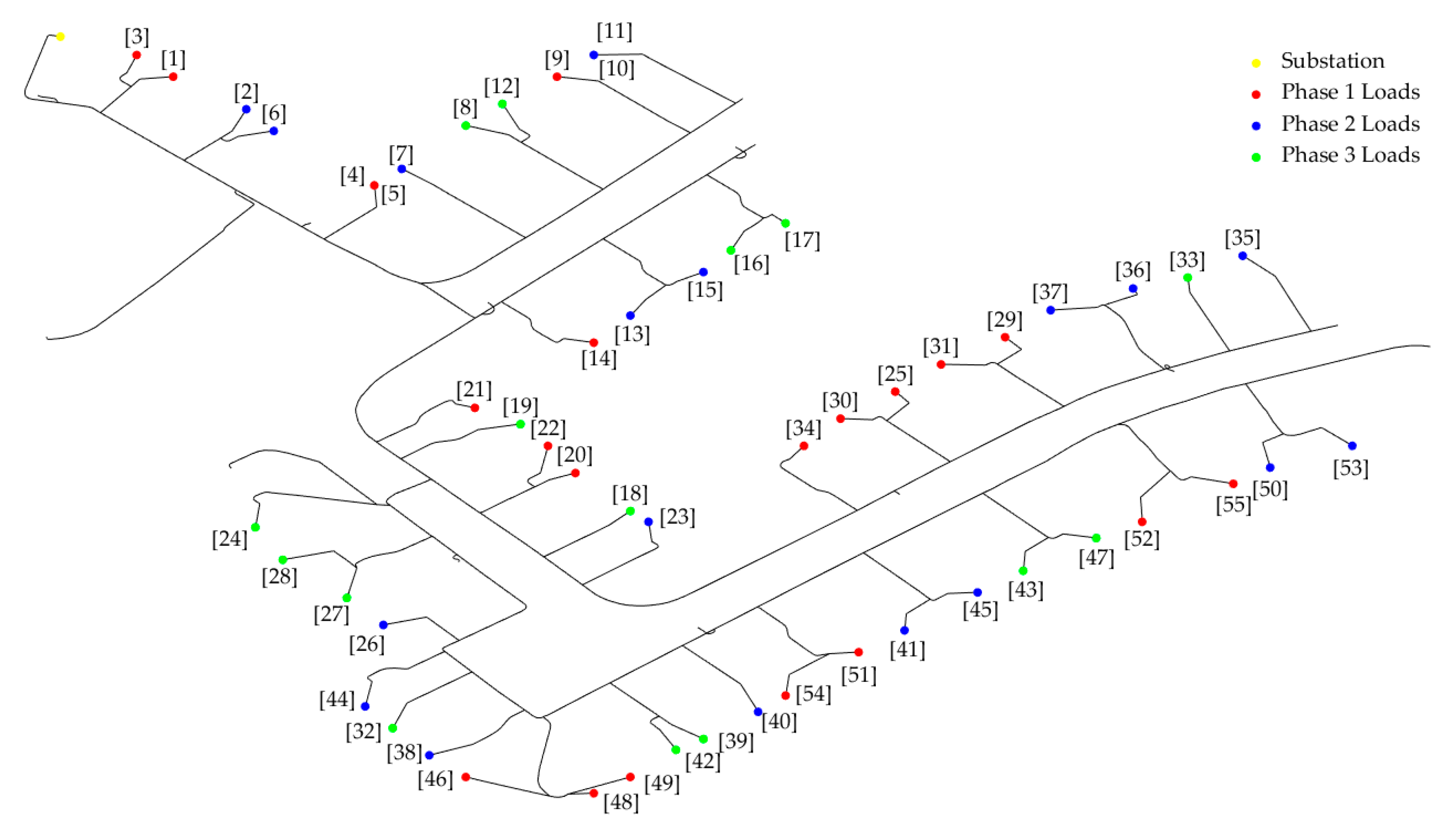
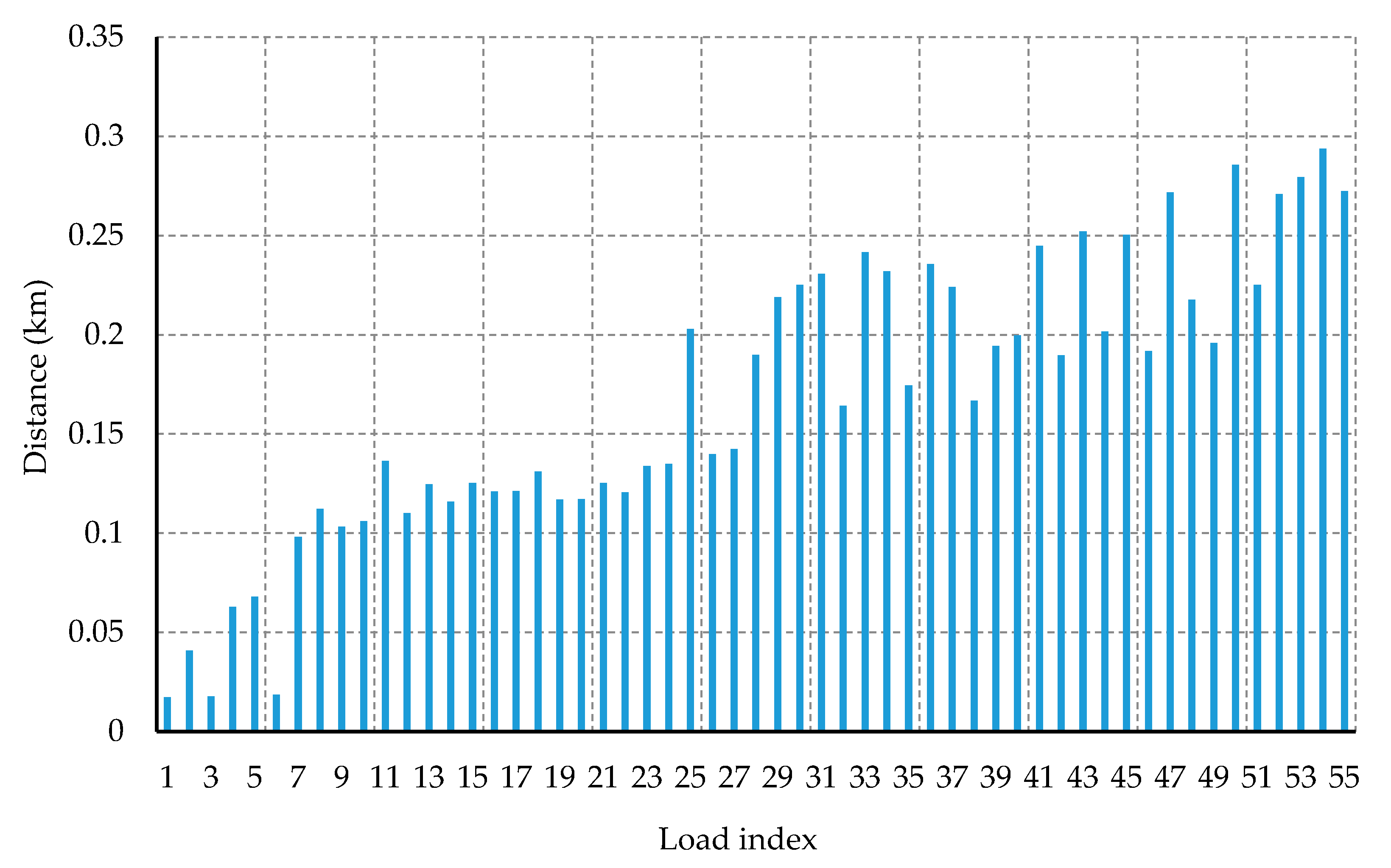
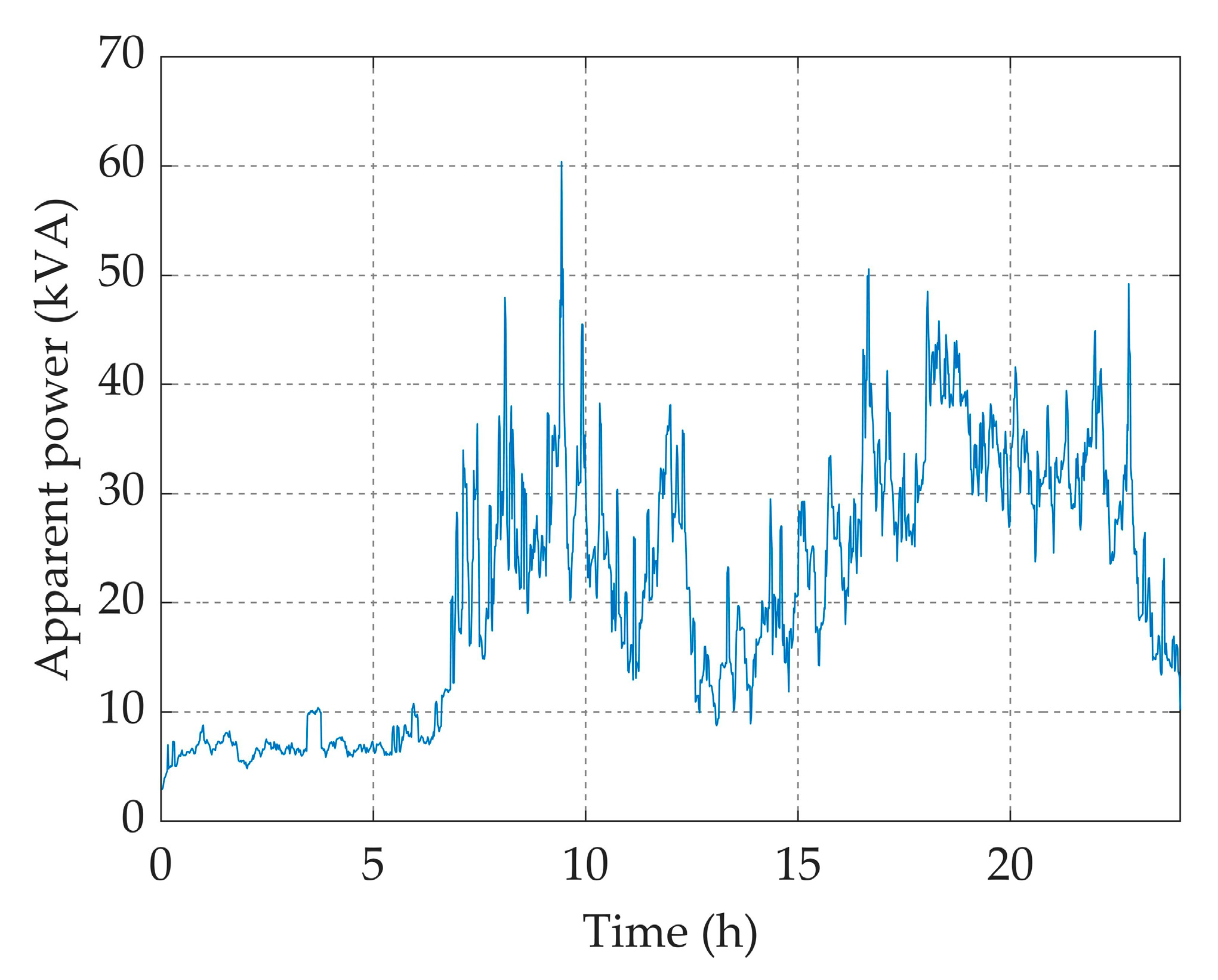
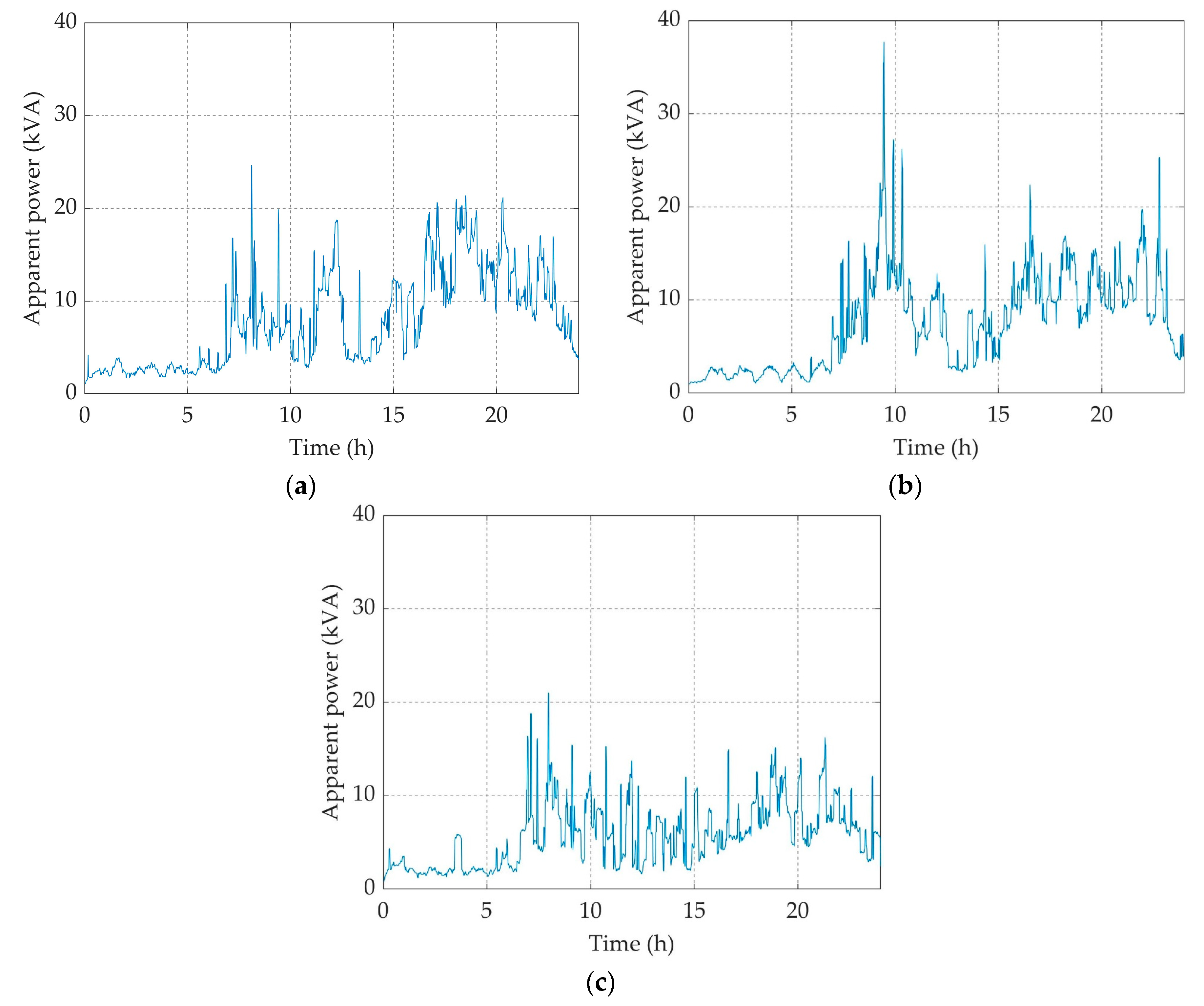


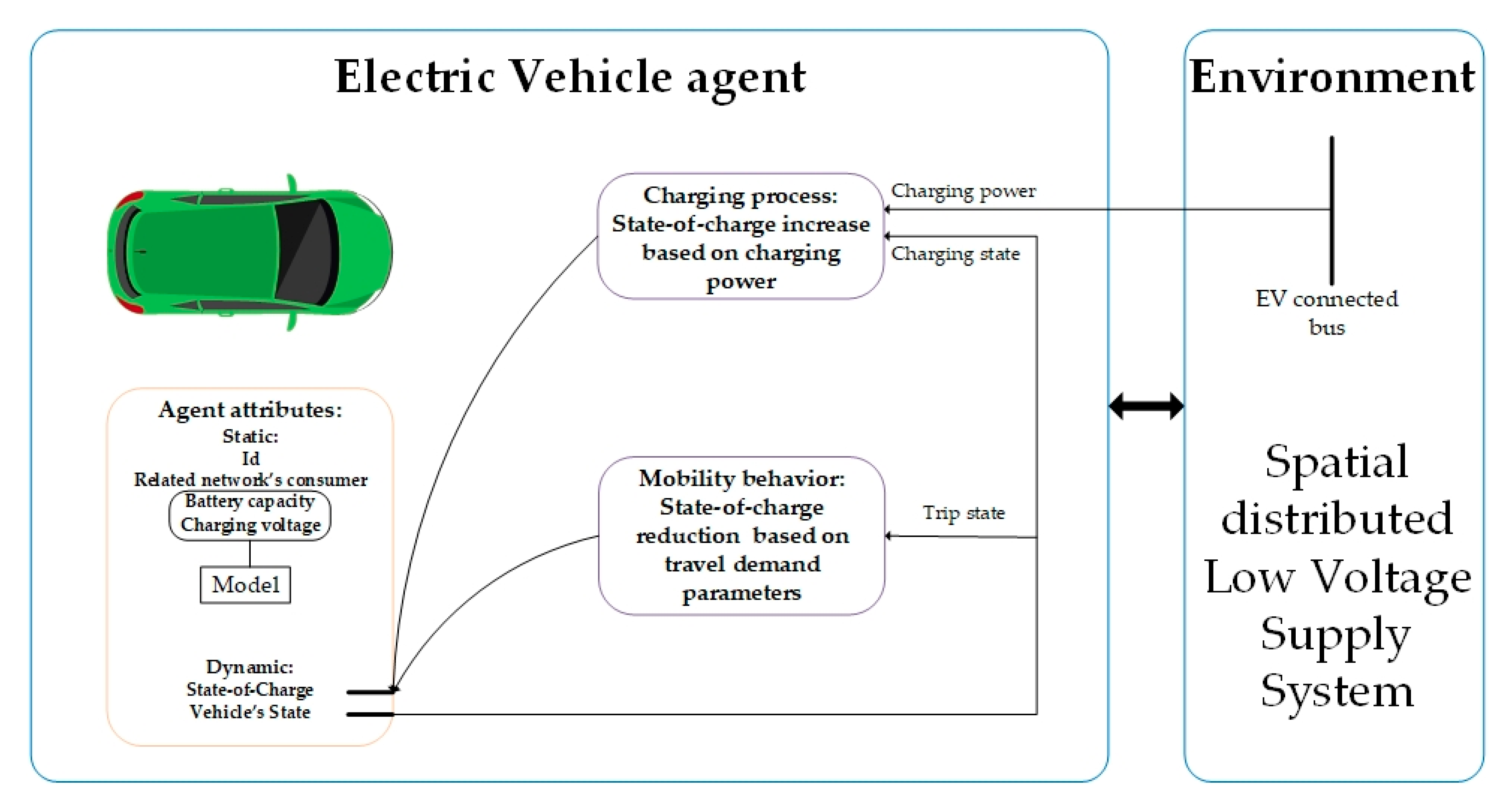
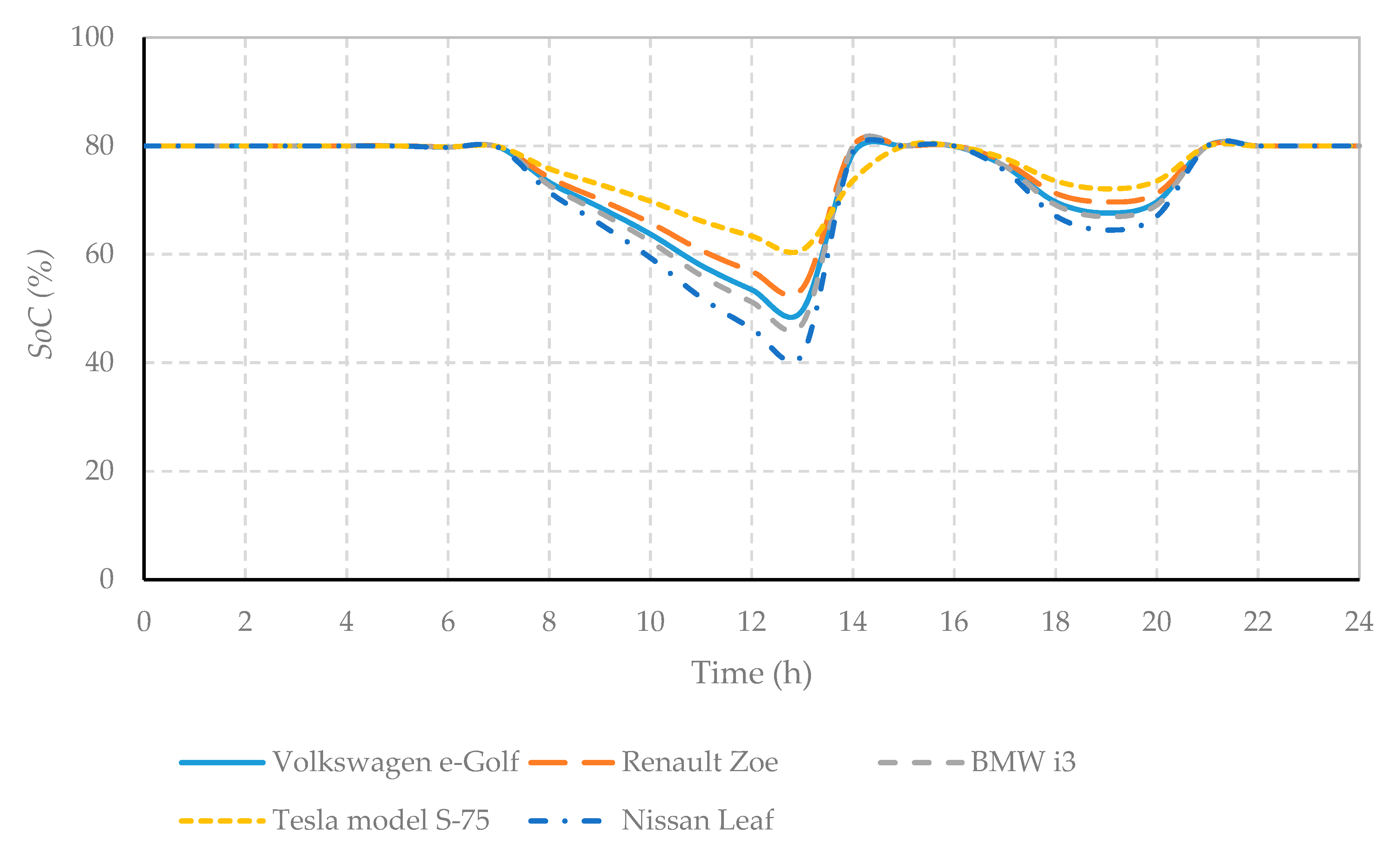

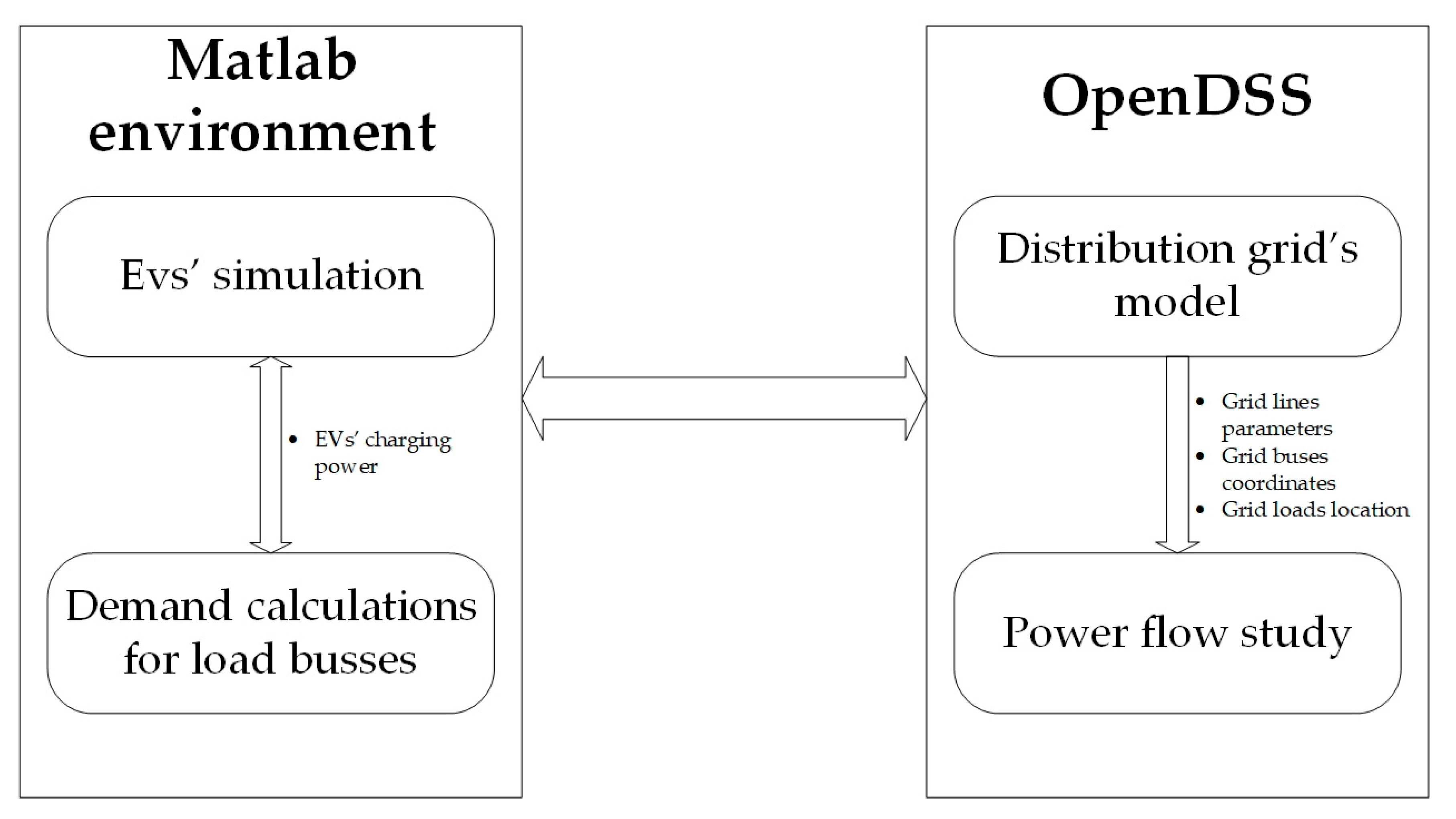


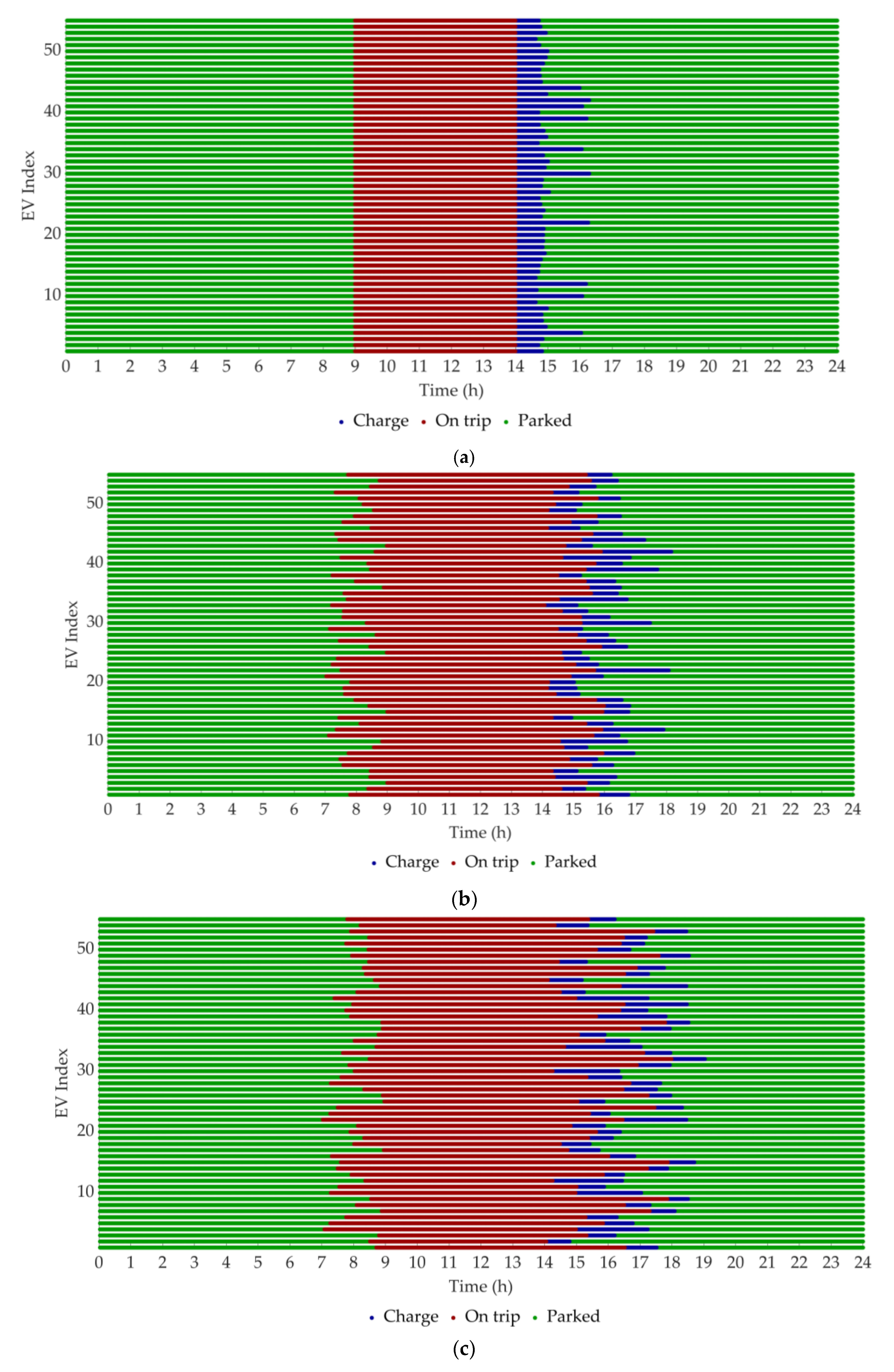

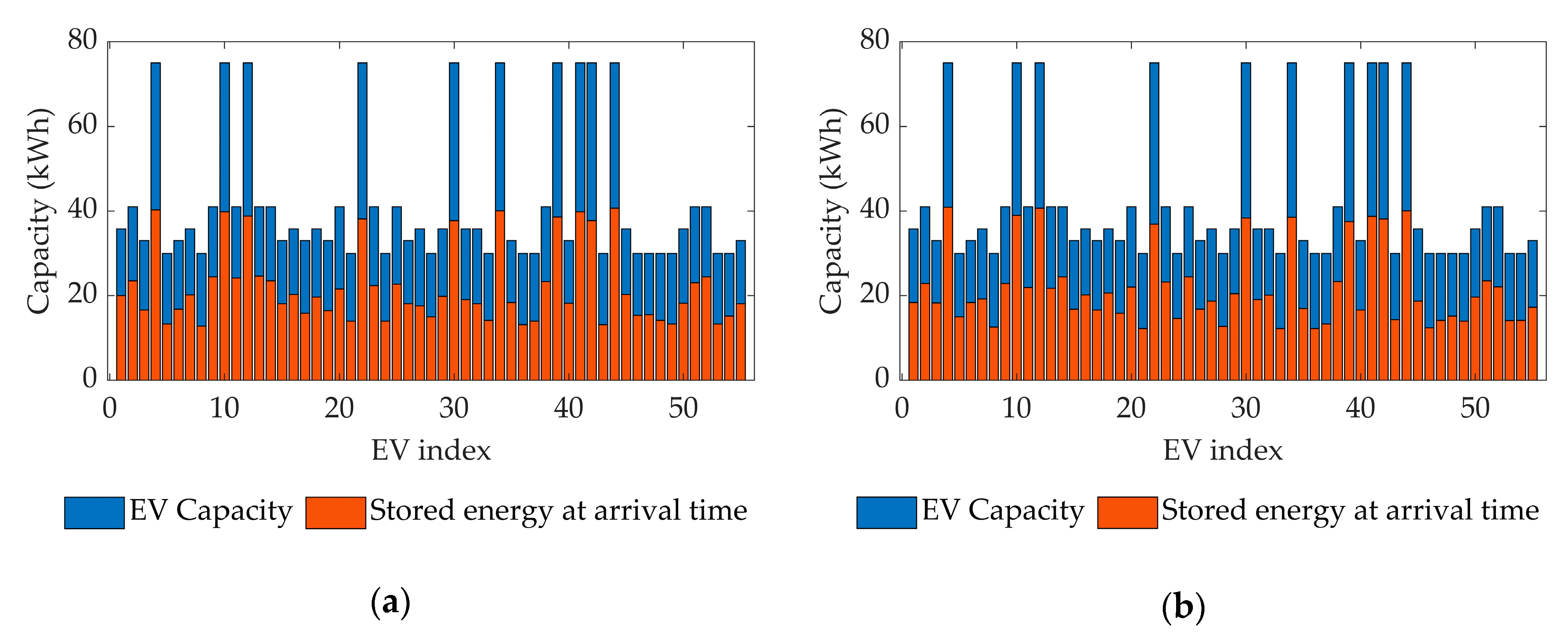



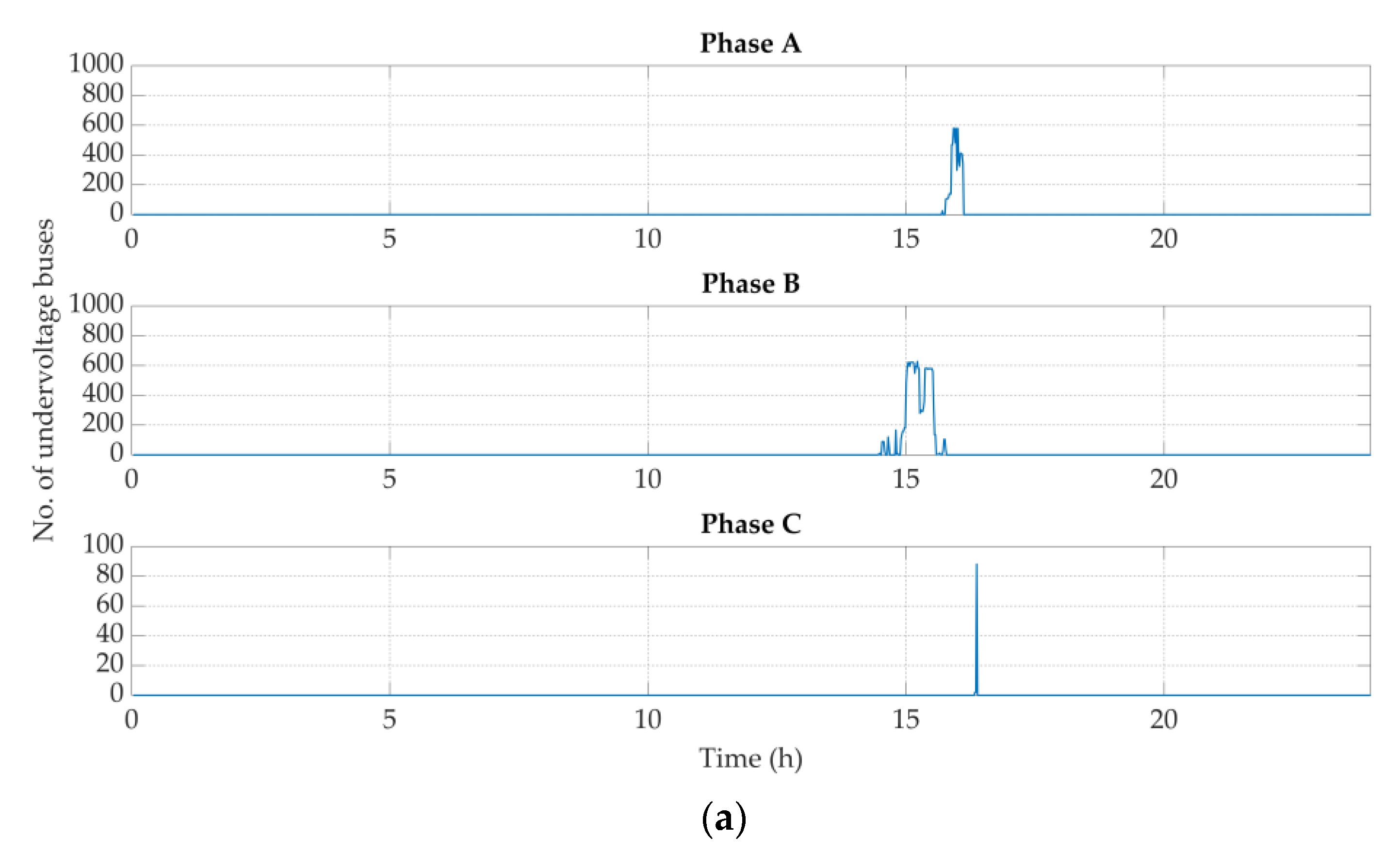
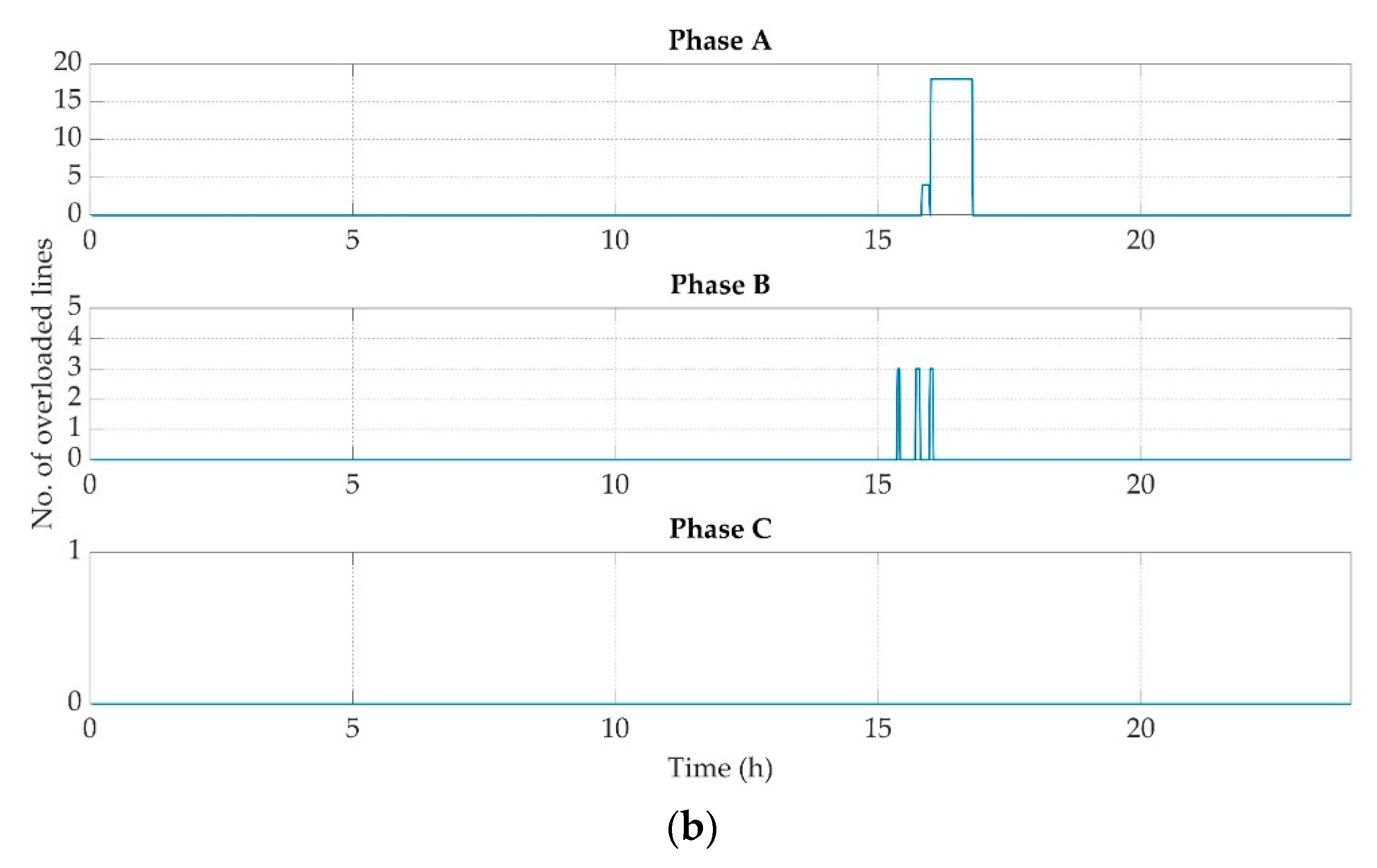



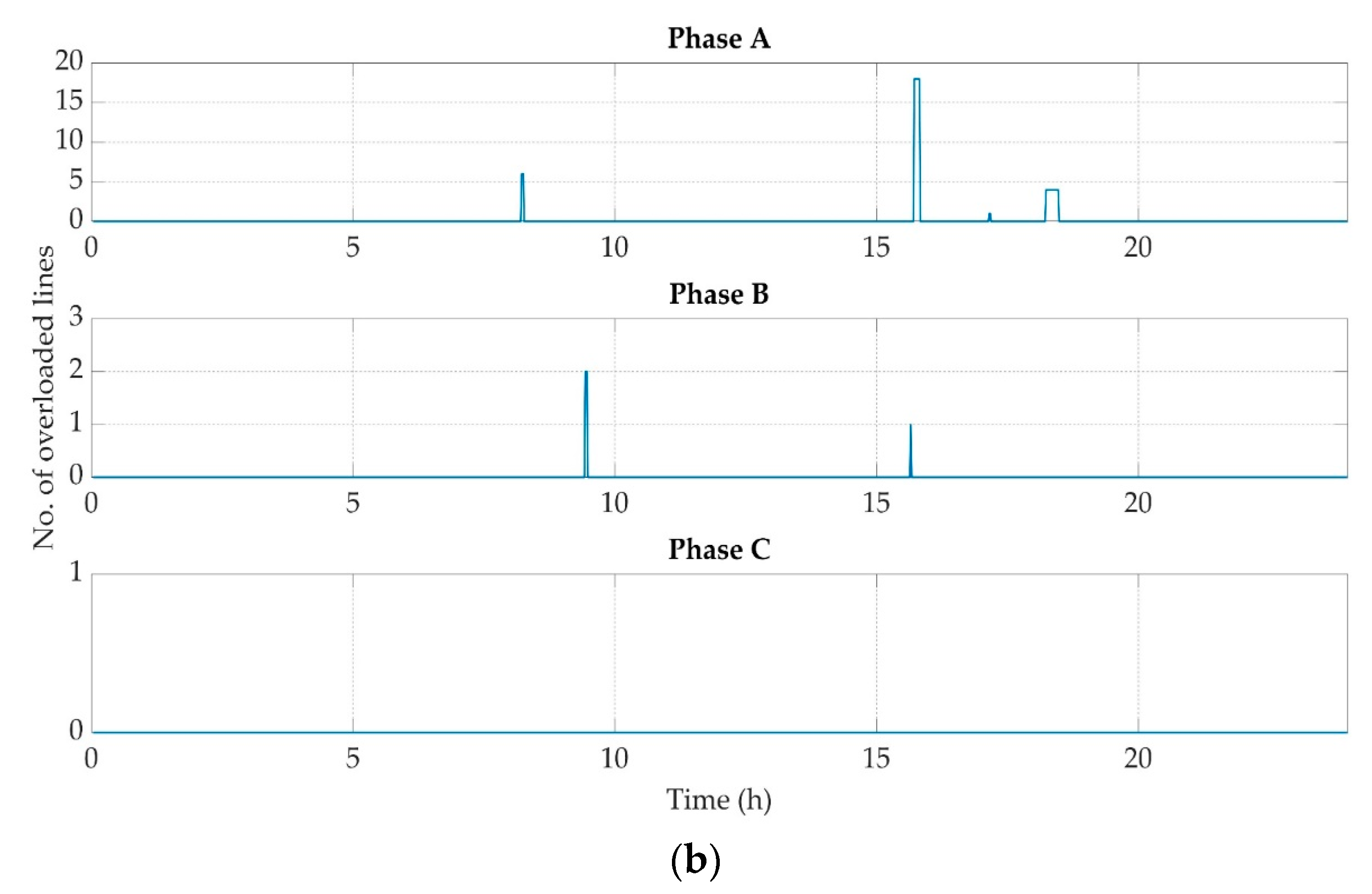
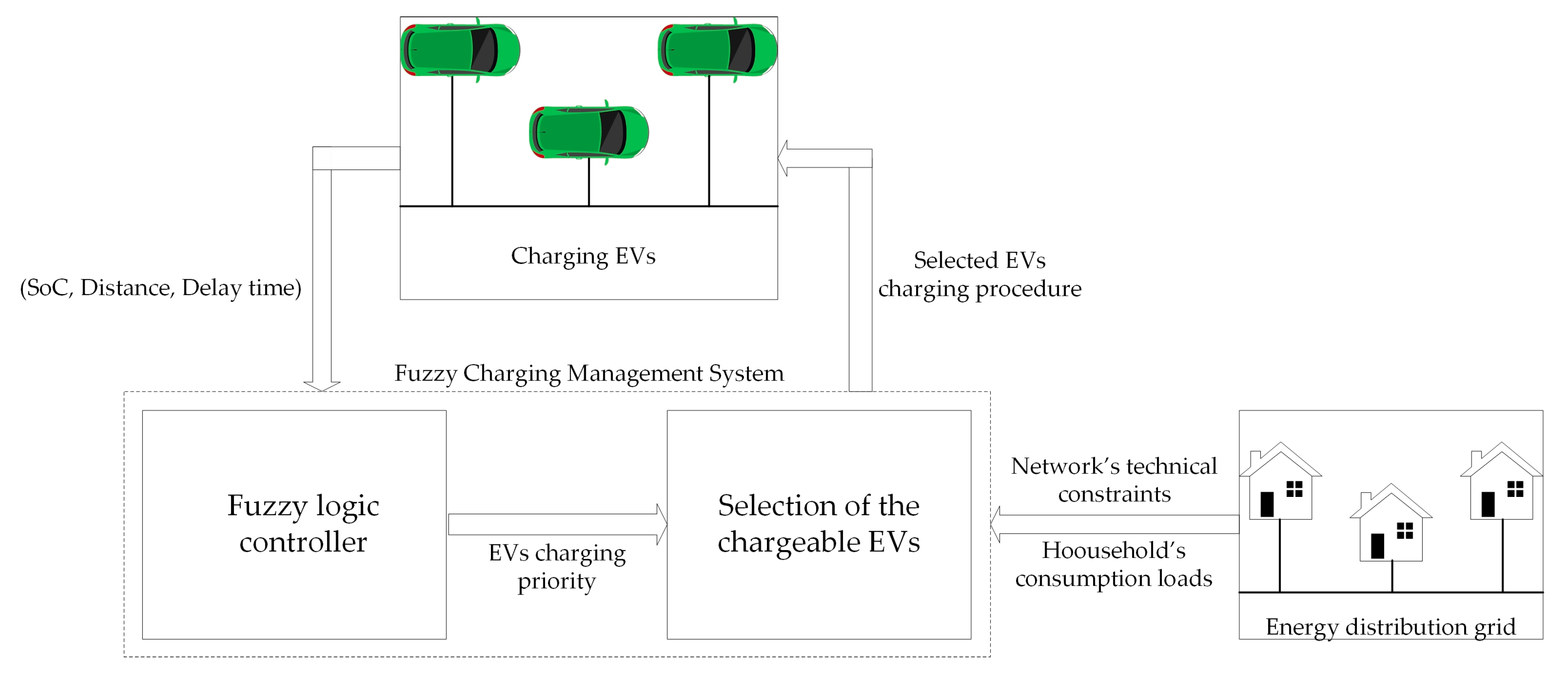
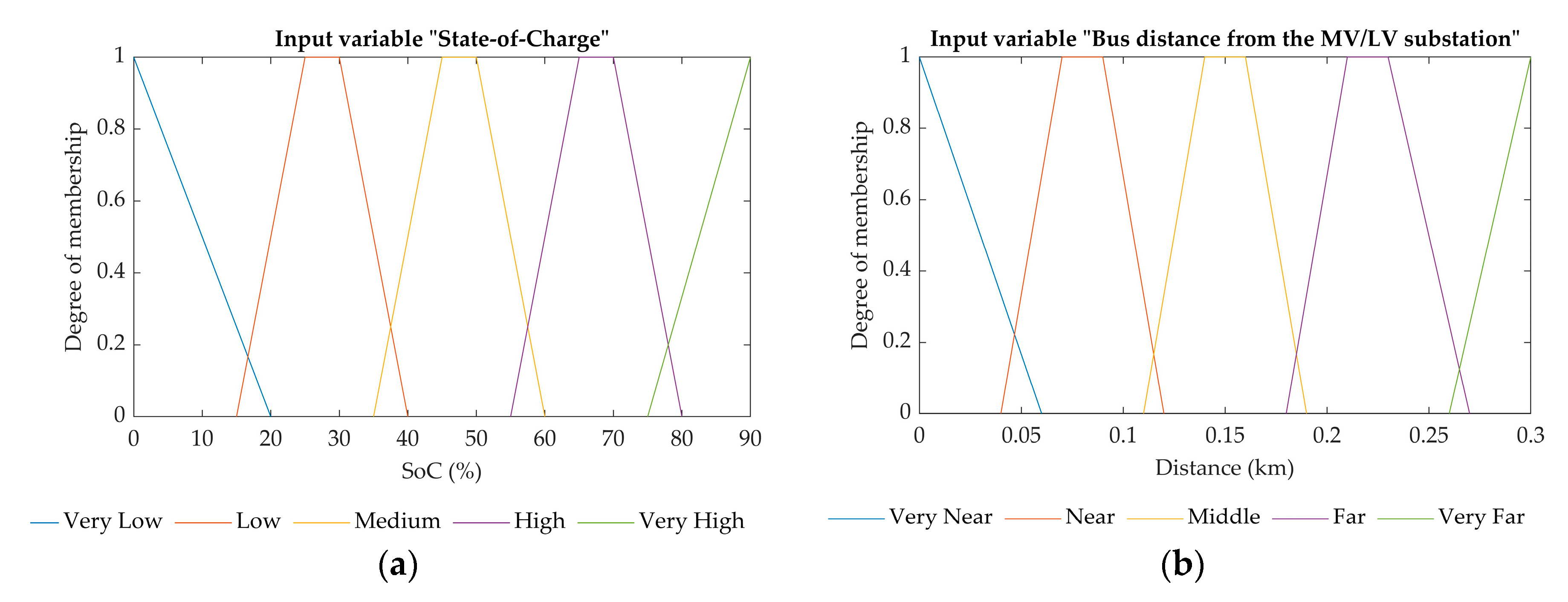

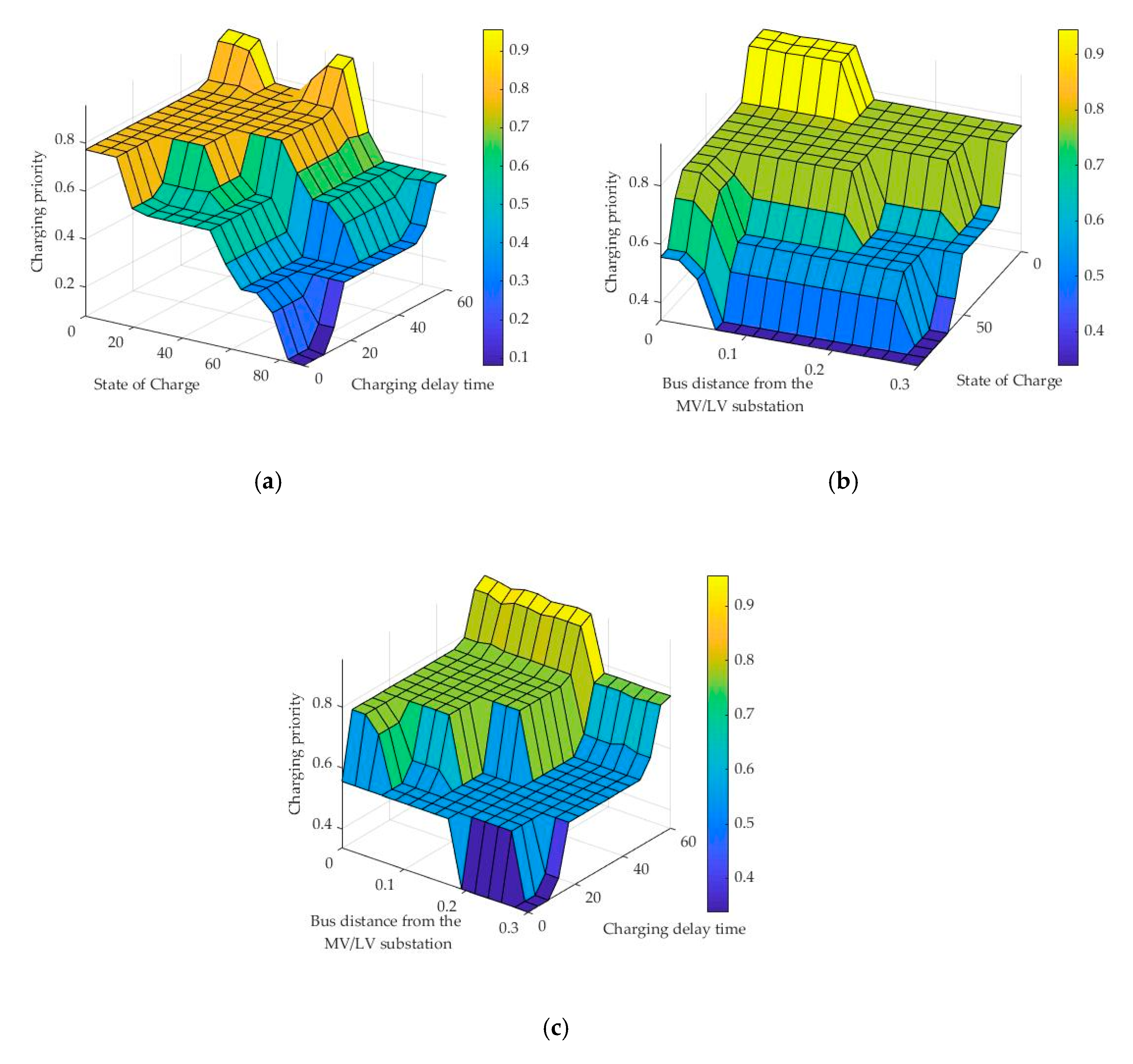


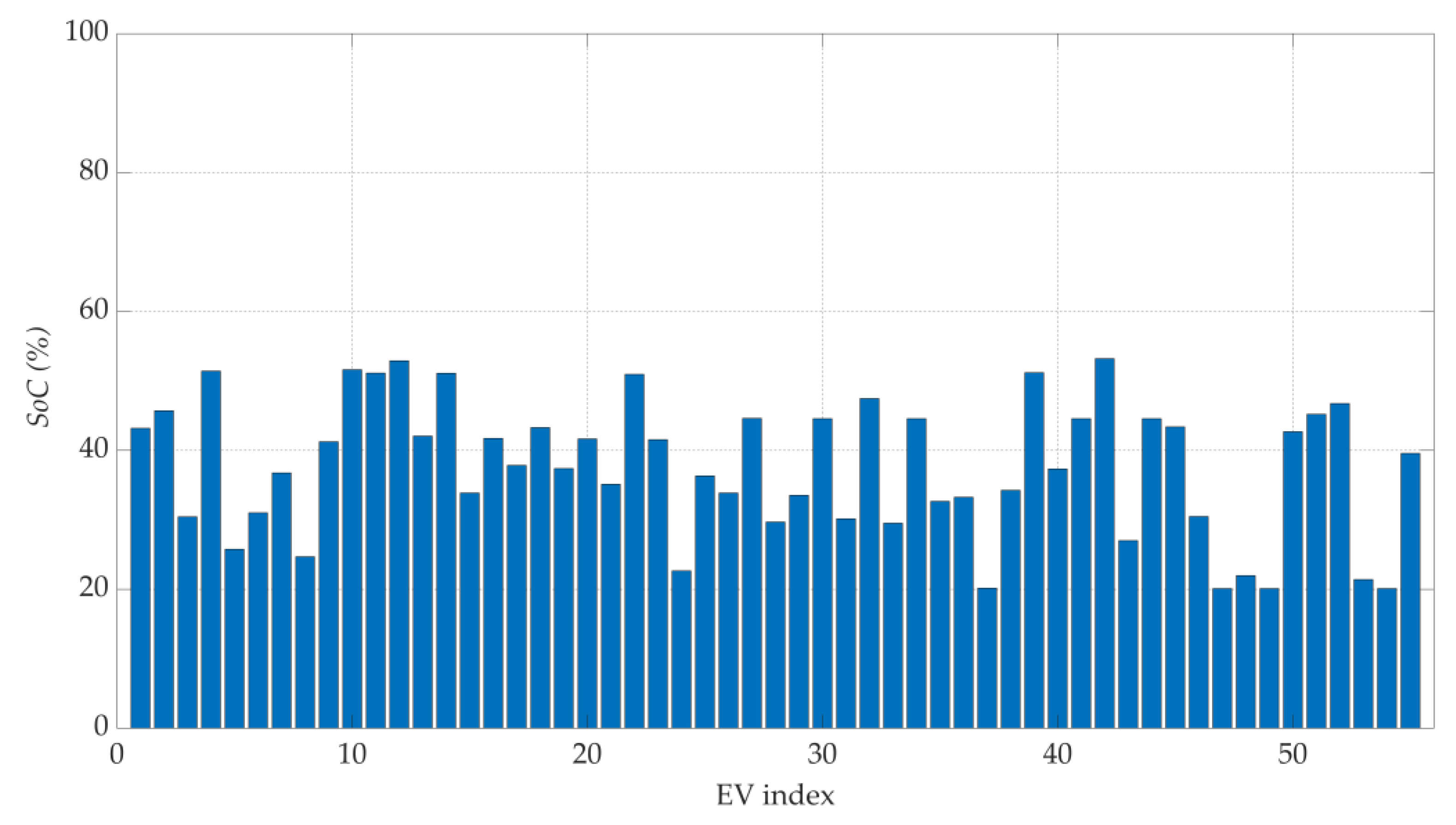
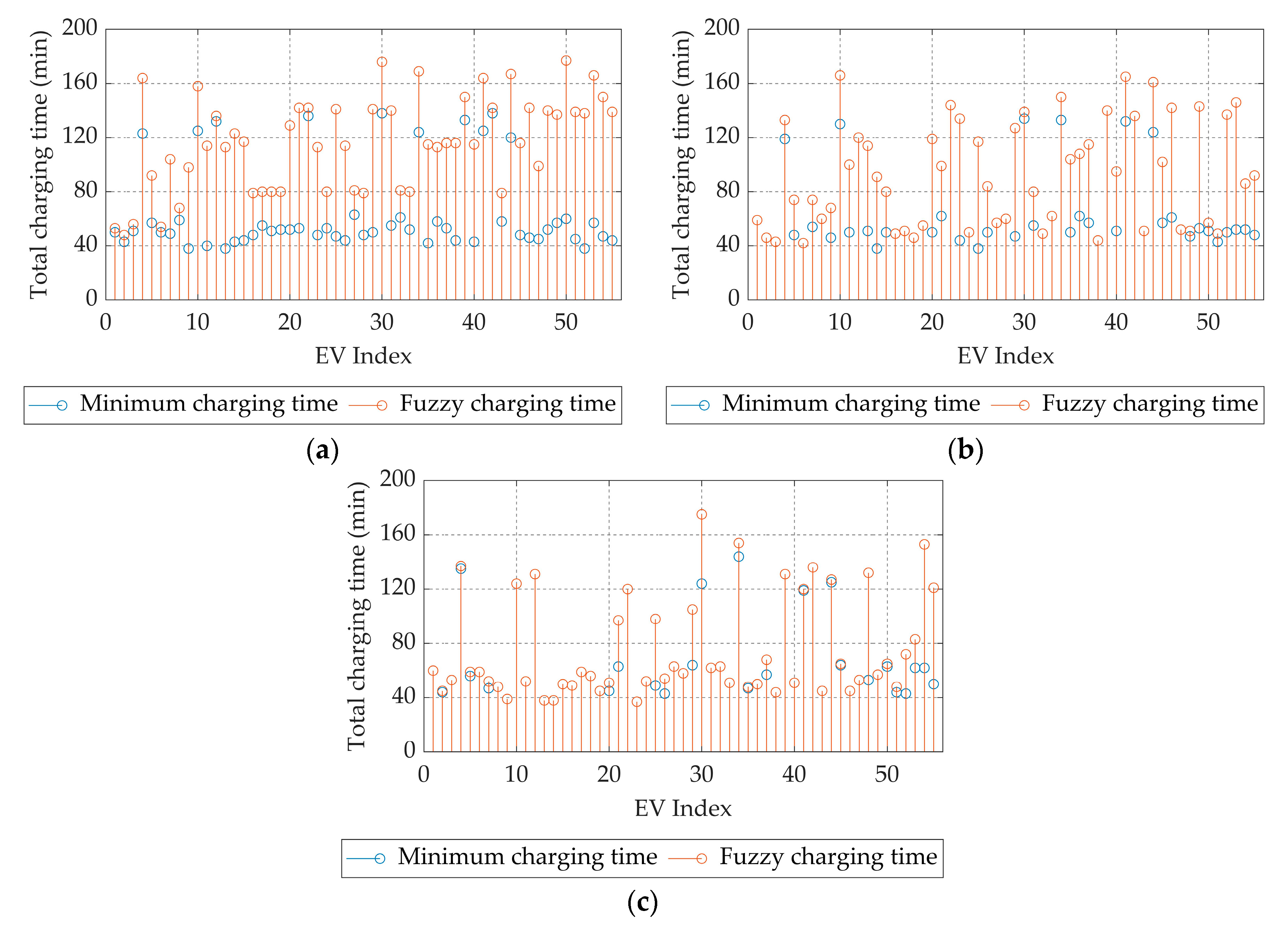

| Reference Point | Peak Load Apparent Power (kVA) | Peak Load Active Power (KW) | Average Energy Consumption (kWh/day) |
|---|---|---|---|
| Transformer | 60.37 | 57.36 | 20.16 |
| Phase A | 24.59 | 23.36 | 7.50 |
| Phase B | 37.71 | 35.82 | 7.22 |
| Phase C | 21.01 | 19.96 | 5.44 |
| Line Code | Ampacity (A) |
|---|---|
| 2c 007 | 56 |
| 2c 0225 | 83 |
| 2c 16 | 83 |
| 35 SAC XSC | 110 |
| 4c 06 | 210 |
| 4c 1 | 560 |
| 4c 35 | 210 |
| 4c 185 | 405 |
| 4c 70 | 560 |
| 4c 95 SAC XC | 180 |
| Model | Capacity (kWh) | Type of Battery | Travel Range (km) | Energy Consumption per km (kWh/km) |
|---|---|---|---|---|
| BMW i3 | 33.0 | Lithium-ion | 183.4 | 0.16 |
| Nissan Leaf | 30.0 | Lithium-ion | 172.2 | 0.17 |
| Renault Zoe | 41.0 | Lithium-ion | 402.3 | 0.16 |
| Volkswagen e-Golf | 35.8 | Lithium-ion | 193.1 | 0.16 |
| Tesla Model S-75 | 75.0 | Lithium-ion | 400.7 | 0.21 |
| Case Studies | CS1 | CS2 | ||||
|---|---|---|---|---|---|---|
| Chargeable EVs | Mean | Variance | Mean Utilization | Mean | Variance | Mean Utilization |
| Total chargeable EVs | 34.27 | 8.81 | 62.3 % | 22.45 | 3.94 | 40.8 % |
| Chargeable EVs of Phase A | 11.52 | 2.52 | 54.9 % | 7.31 | 0.55 | 35.0 % |
| Chargeable EVs of Phase B | 11 | 1.09 | 56.6 % | 8.28 | 0.51 | 43.6 % |
| Chargeable EVs of Phase C | 12 | 1.78 | 80.0 % | 6.84 | 1.03 | 45.6% |
| Scenario | Departure Time Period (hh:mm) | Arrival Time Period (hh:mm) |
|---|---|---|
| Scenario 1 | 9:00 | 14:00 |
| Scenario 2 | 7:00–9:00 | 14:00–16:00 |
| Scenario 3 | 7:00–9:00 | 14:00–18:00 |
| Scenario 4 | Random | Random |
| Model | Number of EVs |
|---|---|
| BMW i3 | 9 |
| Nissan Leaf | 15 |
| Renault Zoe | 11 |
| Volkswagen e | 10 |
| Tesla Model 3 | 10 |
| FLC inputs | |
| Variables | Fuzzy States |
| SoC | Very Low, Low, Medium, High, Very High |
| Bus distance from the MV/LV substation | Very Near, Near, Middle, Far, Very Far |
| Charging delay time | Very Low, Low, Medium, High, Very High |
| FLC output | |
| Variable | Fuzzy States |
| Charging priority | Very Low, Low, Medium, High, Very High |
| SoC\Delay Time | Very Low | Low | Medium | High | Very High |
|---|---|---|---|---|---|
| Very Low | High | High | High | Very High | Very High |
| Low | High | High | High | High | Very High |
| Medium | Medium | High | High | High | Very High |
| High | Medium | Medium | Medium | High | High |
| Very High | Low | Low | Low | Medium | Medium |
| SoC\Delay Time | Very Low | Low | Medium | High | Very High |
|---|---|---|---|---|---|
| Very Low | High | High | High | Very High | Very High |
| Low | Medium | High | High | High | Very High |
| Medium | Medium | Medium | High | High | Very High |
| High | Low | Medium | Medium | Medium | High |
| Very High | Very Low | Low | Low | Low | Medium |
| SoC\Delay Time | Very Low | Low | Medium | High | Very High |
|---|---|---|---|---|---|
| Very Low | High | High | High | High | Very High |
| Low | Medium | Medium | High | High | High |
| Medium | Medium | Medium | Medium | High | Very High |
| High | Low | Low | Low | Medium | Medium |
| Very High | Very Low | Very Low | Low | Low | Medium |
| SoC\Delay Time | Very Low | Low | Medium | High | Very High |
|---|---|---|---|---|---|
| Very Low | Medium | High | High | High | Very High |
| Low | Medium | Medium | Medium | High | High |
| Medium | Low | Medium | Medium | Medium | High |
| High | Low | Low | Low | Medium | Medium |
| Very High | Very Low | Very Low | Low | Low | Medium |
| SoC\Delay Time | Very Low | Low | Medium | High | Very High |
|---|---|---|---|---|---|
| Very Low | Medium | Medium | High | High | Very High |
| Low | Medium | Medium | Medium | Medium | High |
| Medium | Low | Low | Medium | Medium | High |
| High | Very Low | Low | Low | Low | Medium |
| Very High | Very Low | Very Low | Very Low | Low | Low |
| Scenario | Mean Charging Time of EVs in FLC− (min) | Mean Charging Time of EVs in FLC+ (min) | Percentage of Charging Time Reduction (%) |
|---|---|---|---|
| Scenario 1 | 136 | 116 | 14.7 |
| Scenario 2 | 107 | 93 | 13 |
| Scenario 3 | 80 | 75 | 6 |
© 2020 by the authors. Licensee MDPI, Basel, Switzerland. This article is an open access article distributed under the terms and conditions of the Creative Commons Attribution (CC BY) license (http://creativecommons.org/licenses/by/4.0/).
Share and Cite
Boglou, V.; Karavas, C.-S.; Arvanitis, K.; Karlis, A. A Fuzzy Energy Management Strategy for the Coordination of Electric Vehicle Charging in Low Voltage Distribution Grids. Energies 2020, 13, 3709. https://doi.org/10.3390/en13143709
Boglou V, Karavas C-S, Arvanitis K, Karlis A. A Fuzzy Energy Management Strategy for the Coordination of Electric Vehicle Charging in Low Voltage Distribution Grids. Energies. 2020; 13(14):3709. https://doi.org/10.3390/en13143709
Chicago/Turabian StyleBoglou, Vasileios, Christos-Spyridon Karavas, Konstantinos Arvanitis, and Athanasios Karlis. 2020. "A Fuzzy Energy Management Strategy for the Coordination of Electric Vehicle Charging in Low Voltage Distribution Grids" Energies 13, no. 14: 3709. https://doi.org/10.3390/en13143709
APA StyleBoglou, V., Karavas, C.-S., Arvanitis, K., & Karlis, A. (2020). A Fuzzy Energy Management Strategy for the Coordination of Electric Vehicle Charging in Low Voltage Distribution Grids. Energies, 13(14), 3709. https://doi.org/10.3390/en13143709








